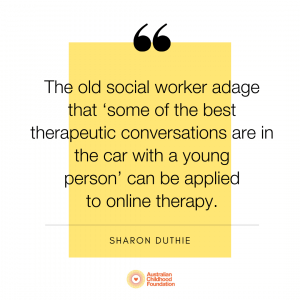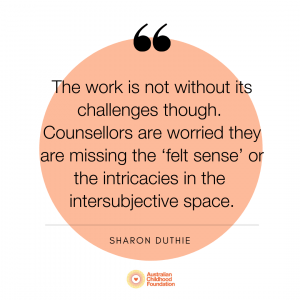
A unique window into our world – a supervisors reflections on therapy in the time of COVID19
As the global pandemic COVID-19 has swept across the world, so too have sweeping changes to the way we practice. We are now seeing the parent/carers, children and young people online for therapy. We are seeing them through a different lens; quite literally through a window on a computer screen. This offers us a new way to view them, and for them to view us.
This blog is written by Sharon Duthie, a Team Leader in the Australian Childhood Foundation’s Therapeutic Services.
As the global pandemic COVID-19 has swept across the world, so too have sweeping changes to the way we practice. We are now seeing the parent/carers, children and young people online for therapy. We are seeing them through a different lens; quite literally through a window on a computer screen. This offers us a new way to view them, and for them to view us.
As a team leader supervising several staff at this pivotal time in our history, I am hearing many stories from the frontline– that is, the online counselling frontline. I am often in awe of the adaptations that our counsellors, and our clients, have made during this time, and thought I’d share some reflections.
My colleagues have adapted so quickly to this new way of the world. At ACF we were lucky enough to have the equipment and platforms to go home and continue the important work we do, to carry on providing therapy but online instead of person to person. We went from one day having sessions in person at our trauma counselling centre in Mitcham, Melbourne, to the following day using online platforms to engage our vulnerable client group. I’m not only incredibly impressed with the resourcefulness, creativity and adaptability of the staff but also that of our clients – parents, grandparents, out of home carers and the children and young people, and of other professionals.
 What I have noticed in supervisions and discussions with the team is that this modification in service delivery has provided a unique opportunity to see into the worlds of our clients in a way previously unknown. Sometimes these windows into their worlds are unpredictable and confronting, as well as real and authentic. This ‘new way’ has provided an unexpected therapeutic opportunity. The counsellors can see interactions with carers/parents and children that they just wouldn’t normally observe. As normally we are not in unprecedented times that provoke fear and anxiety, as well as other stress responses such as hyperarousal, hypervigilance and defensiveness or reactivity.
What I have noticed in supervisions and discussions with the team is that this modification in service delivery has provided a unique opportunity to see into the worlds of our clients in a way previously unknown. Sometimes these windows into their worlds are unpredictable and confronting, as well as real and authentic. This ‘new way’ has provided an unexpected therapeutic opportunity. The counsellors can see interactions with carers/parents and children that they just wouldn’t normally observe. As normally we are not in unprecedented times that provoke fear and anxiety, as well as other stress responses such as hyperarousal, hypervigilance and defensiveness or reactivity.
Technology can frustrate the best us. Observing the child and parent/carer during a moment (or three) of frustration allows the counsellor to see into their Windows of Tolerance – how did they speak to each other? How quickly were they able to diffuse the situation? How long was the child (and parent) out of their window? Did there need to be repair? Did this happen, and how long did it take? This ‘in the moment’ observation offers an opportunity to observe their relationship from an alternative angle. The counsellors can use these moments therapeutically to acknowledge, be curious and support regulation, or whatever it is that the child and parent/carer need in those moments. These are therapeutic opportunities that are sometimes not available in the more controlled environments of counselling rooms.
Some counsellors are experiencing better engagement with children and young people. They are reporting that clients are more engaged, more authentic and less guarded – particularly adolescents. It’s almost like the old social worker adage that ‘some of the best therapeutic conversations are in the car with a young person’ can be applied to online therapy. Perhaps it has something to do with not making direct eye contact or feeling the need to; or perhaps it’s just less confronting than being in a room in close proximity. Or maybe today’s youth are simply more comfortable communicating in an online environment.
If we looked at it through the Stephen Porges Polyvagal theory lens, there may in fact be greater safety in online interactions. For some children and young people, it may be less threatening online because screens have been used previously to regulate and calm. For many children today, online is the preferred method of communication. And for some of our traumatised children and young people, being in a room with an adult can activate the vagal circuitry into the stress response, particularly if the child’s template is that adults aren’t safe. For some children and young people, it may be less threatening online because it takes away the element of perceived threat.
Our clients can also see whatever world we want to create for them – so much thought and consideration has gone into what counsellor’s “show” of themselves and the online counselling space they are creating. It should be designed for clients to feel safe, anchored, grounded. Some staff have ACF posters on the wall behind them and others have familiar toys/miniatures or art materials that the client can identify with. One counsellor has stuck the Bear cards on the wall as this was a tool they used every week to check in prior to COVID-19 restrictions. The counsellors have worked closely and collaboratively with parents and carers to help prepare for what the child needs for the session in advance.
 The work is not without its challenges though. Counsellors are worried they are missing the ‘felt sense’ or the intricacies in the intersubjective space. Counsellors have mentioned that it can be harder to “get it right” via the screen. However, this has in fact led to more checking in and wondering if they are on the right track. Another challenge of the work is that some of the non-verbal cues are missing, especially if children and young people can only be seen from the shoulders up. For example, the adolescent quickly tapping their foot to regulate through a session, this may be missing.
The work is not without its challenges though. Counsellors are worried they are missing the ‘felt sense’ or the intricacies in the intersubjective space. Counsellors have mentioned that it can be harder to “get it right” via the screen. However, this has in fact led to more checking in and wondering if they are on the right track. Another challenge of the work is that some of the non-verbal cues are missing, especially if children and young people can only be seen from the shoulders up. For example, the adolescent quickly tapping their foot to regulate through a session, this may be missing.
I believe, however, that this new window, this alternative perspective into our clients lives during this unusual time is invaluable. I think in some cases it has deepened the therapeutic alliance and connection; as we all experience this, hopefully, once in a lifetime event. I know the staff I supervise are eager to get back into the counselling rooms, but the window created by the pandemic and the forced adoption of a new way of working has created an opportunity to deepen and strengthen their work with families. Research has indicated that many great developments in skills, techniques and understanding are brought about in times of stress. No doubt, we will come out of the COVID-19 experience with a greater understanding of ourselves, our clients and the possibilities and limitations of our work.
This is a time which we will all look back and remember in different ways. I feel that many of the children who attend the Child Trauma Service will look back on this time as a time when the outside looked in through their window, a window that may have otherwise been closed. It is not only the virtual window into their world that we see, but it’s also the window into their lives during this unique time that provides an extra layer of richness to the understanding and meeting the needs of the children and families that attend our service.
